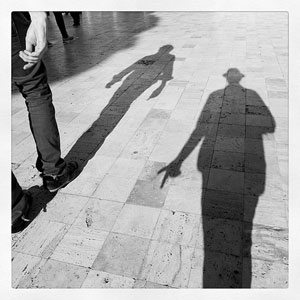
Source: .@n8thesk8 & I at #GettySocial. Got Inspired by #Metzker Exhibit., nicadlr, Flickr
One way that poets add meaning to their poems is by using language that creates pictures in the minds of readers. They accomplish this through sensory language, or language that appeals to one or more of the five senses: sight, sound, touch, smell, and taste. Poets also use sound devices such as alliteration and onomatopoeia.
The first poem you will read in this lesson is by Joan Mitchell, who was also a painter. She published the poem below at the age of ten. Read the poem and follow the instructions for the activity afterward.
Autumn
By Joan Mitchell
The rusty leaves crunch and crackle,
Blue haze hangs from the dimmed sky,
The fields are matted with sun-tanned stalk—
Wind rushes by.
The last red berries hang from the thorn-tree,
The last red leaves fall to the ground.
Bleakness, through the tree and bushes,
Comes without sound.
Source: Purple Berries, Eddie Hales, Flickr
Click, hold, and move your cursor in a circular motion on the dial below. As you slowly turn the dial, read about each poetic device found in “Autumn.”

 Each image and device, along with words such as “red,” “blue,” and “sun-tanned,” help create a picture of the late fall season. Choose your favorite season and use your notes to list some colors and images that come to mind when you think of that season. When you’re finished, check your understanding to view some possible responses.
Each image and device, along with words such as “red,” “blue,” and “sun-tanned,” help create a picture of the late fall season. Choose your favorite season and use your notes to list some colors and images that come to mind when you think of that season. When you’re finished, check your understanding to view some possible responses.
Sample Responses:
Spring
Blue, green, rain, fragrant flowers, new tree growth, sunshine, birds chirping, soft breezes
Summer
Yellow, white, hot sun, warm sand, ocean waves, smell of salt water, crickets chirping, taste of watermelon, honeysuckle, peaches
Fall
Red, orange, brown, gold leaves, taste of pumpkins, cool winds, crackling leaves, smell of cinnamon and spices
Winter
White, silver, bare trees, icicles, snow, cold, whistling winds, crunching sound of walking on snow, smells of fireplaces burning
When studying a poem, you need to start by identifying the poet’s use of figurative devices. Next, you need to use this information, or evidence, to make inferences.
In “Autumn,” for example, the poem shows several images of fall. These images build until “the last red berries” and “the last red leaves” of the season “fall to the ground.” You might make an inference that the speaker is showing us how the colors of fall give way to the “bleakness” of winter.